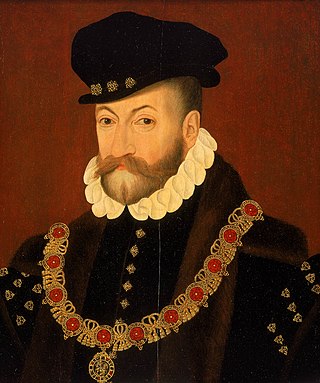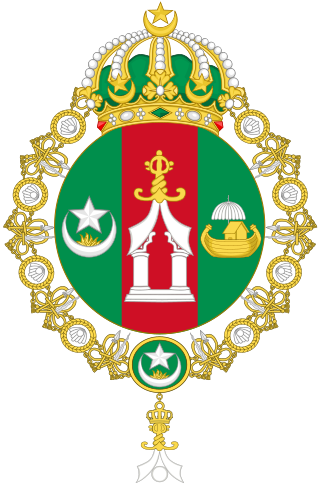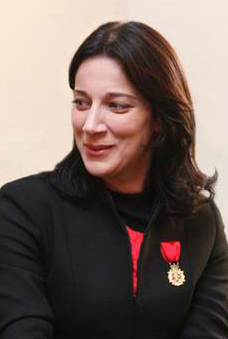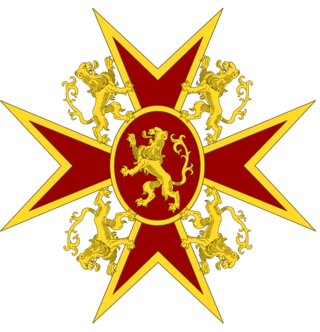
The Most Excellent Order of the British Empire is a British order of chivalry, rewarding contributions to the arts and sciences, work with charitable and welfare organizations, and public service outside the civil service. It was established on 4 June 1917 by King George V and comprises five classes across both civil and military divisions, the most senior two of which make the recipient either a knight if male or dame if female. There is also the related British Empire Medal, whose recipients are affiliated with, but not members of, the order.
Sir is a formal honorific address in English for men, derived from Sire in the High Middle Ages. Both are derived from the old French "Sieur" (Lord), brought to England by the French-speaking Normans, and which now exist in French only as part of "Monsieur", with the equivalent "My Lord" in English. Traditionally, as governed by law and custom, Sir is used for men who are knights and belong to certain orders of chivalry, as well as later applied to baronets and other offices. As the female equivalent for knighthood is damehood, the suo jure female equivalent term is typically Dame. The wife of a knight or baronet tends to be addressed as Lady, although a few exceptions and interchanges of these uses exist.

Fuad I was the Sultan and later King of Egypt and the Sudan. The ninth ruler of Egypt and Sudan from the Muhammad Ali dynasty, he became Sultan in 1917, succeeding his elder brother Hussein Kamel. He replaced the title of Sultan with King when the United Kingdom unilaterally declared Egyptian independence in 1922.

The Most Honourable Order of the Bath is a British order of chivalry founded by King George I on 18 May 1725. Recipients of the Order are usually senior military officers or senior civil servants, and the monarch awards it on the advice of His Majesty's Government. The name derives from an elaborate medieval ceremony for preparing a candidate to receive his knighthood, of which ritual bathing was an element. While not all knights went through such an elaborate ceremony, knights so created were known as "knights of the Bath".

The Most Distinguished Order of Saint Michael and Saint George is a British order of chivalry founded on 28 April 1818 by George, Prince of Wales, while he was acting as prince regent for his father, King George III. It is named in honour of two military saints, Michael and George.

The New Zealand Order of Merit is an order of merit in the New Zealand royal honours system. It was established by royal warrant on 30 May 1996 by Elizabeth II, Queen of New Zealand, "for those persons who in any field of endeavour, have rendered meritorious service to the Crown and nation or who have become distinguished by their eminence, talents, contributions or other merits", to recognise outstanding service to the Crown and people of New Zealand in a civil or military capacity.

The Royal Guelphic Order, sometimes referred to as the Hanoverian Guelphic Order, is a Hanoverian order of chivalry instituted on 28 April 1815 by the Prince Regent. It takes its name from the House of Guelph, of which the Hanoverians were a branch. Since Hanover and the United Kingdom shared a monarch until 1837, the order was frequently bestowed upon British subjects.
Orders, decorations, and medals of Georgia are the orders, state decorations and medals that are granted by the national government of Georgia for meritorious achievements in national defense, state improvement, and the development of democracy and human rights.

The Bagrationi dynasty is a royal dynasty which reigned in Georgia from the Middle Ages until the early 19th century, being among the oldest extant Christian ruling dynasties in the world. In modern usage, the name of the dynasty is sometimes Hellenized and referred to as the Georgian Bagratids, also known in English as the Bagrations.

Prince Nugzar Petres dze Bagration-Gruzinsky is the head of the princely House of Gruzinsky and represents its disputed claim to the former crown of Georgia.

A collar, also known as collar of an order, is an ornate chain, often made of gold and enamel, and set with precious stones, which is worn about the neck as a symbol of membership in various chivalric orders. It is a particular form of the livery collar, the grandest form of the widespread phenomenon of livery in the Middle Ages and Early Modern Period. Orders which have several grades often reserve the collar for the highest grade. The links of the chain are usually composed of symbols of the order, and the badge of the order normally hangs down in front. Sometimes the badge is referred to by what is depicted on it; for instance, the badge that hangs from the chain of the Order of the Garter is referred to as "the George".

Gruzinsky was a title and later the surname of two different princely lines of the Bagrationi dynasty of Georgia, both of which received it as subjects of the Russian Empire. The name "Gruzinsky" derives from the Russian language, originally and literally meaning "of Georgia". Of the two lines, the younger one is the only line that still exists.

Prince David Bagrationi Mukhrani of Georgia, David Bagration de Moukhrani y Zornoza, or Davit Bagrationi-Mukhraneli, is the Head of the Princely House of Mukhrani, a branch of the Georgian Bagrationi dynasty and claims by primogeniture the headship of the Royal House of Bagrationi, which reigned in Georgia from the medieval era until the early 19th century.

The House of Mukhrani is a Georgian princely family that is a branch of the former royal dynasty of Bagrationi, from which it sprang early in the 16th century, receiving in appanage the domain of Mukhrani, in the Kingdom of Kartli. The family — currently the seniormost genealogical line of the entire Bagrationi dynasty — has since been known as Mukhranbatoni.

The Royal and Hashemite Order of the Pearl is the dynastic order of the Royal House of Sulu, which serves as the premier institution and the highest personal honour of and in the Royal Sultanate of Sulu. The order is an honourable and nobiliary corporation instituted as a dynastic Order of Datuship analogous to traditional dynastic orders of chivalry, and is in direct continuation from the ancient customs and distinctions of the Royal Sultanate of Sulu and the Court of the Sultan. Ampun Sultan Muedzul Lail Tan Kiram, as Head of the Royal House of Sulu, is the hereditary sovereign who processes the fons honorum and Grand Sayyid of the order, and his heirs and successors as heads of the Royal House of Sulu, shall ever be sovereigns and Grand Sayyids of the order.
Giorgi Bagrationi (Georgian: გიორგი ბაგრატიონი;, is a Georgian prince of the Bagrationi dynasty, which reigned until the early 19th century in Georgia and its successive realms.

Princess Ana Bagration-Gruzinsky is a royal princess of the Gruzinsky branch of the Bagrationi dynasty of Georgia.

The Order of the Eagle of Georgia and the Seamless Tunic of Our Lord Jesus Christ commonly known as the Order of the Eagle of Georgia (OEG), is the highest order of chivalry awarded by Crown Prince David Bagration of Mukhrani, the order's Grand Master and a claimant to the throne of Georgia. Prince David became the disputed head of the Royal House of Bagrationi and Grand Master of the order when his father, Prince Giorgi (Jorge) Bagrationi, died.

The Royal Order of the Lion of Godenu is a dynastic Order of Merit in the sub-national kingdom of Godenu, Volta Region of Ghana.















